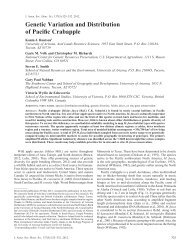CONSERVATION
Conservation You Can Taste - The Southwest Center - University of ...
Conservation You Can Taste - The Southwest Center - University of ...
- No tags were found...
Create successful ePaper yourself
Turn your PDF publications into a flip-book with our unique Google optimized e-Paper software.
Close to 7000 species of plants have been cultivated as food crops worldwide, and 200<br />
or so species of mammals, birds, reptiles, amphibians, fish and invertebrates have been raised<br />
on farms and ranches. However, just 103 crop plants and 7 livestock species feed the world<br />
today in terms of providing the majority of calories and protein consumed in the globalized<br />
economy. Since 1973, when the first major study of the genetic vulnerability of our global food<br />
supply was published, this narrow genetic base for our food supply has alarmed many scientists<br />
and food security planners, especially as another 100,000 kinds of plants and animals have<br />
disappeared from our planet over the last four decades.<br />
But what most global surveys have failed to take into account is the tremendous<br />
momentum that has been made at the grassroots level in North America and elsewhere in<br />
not only conserving but also revitalizing the uses of rare food plant and animal varieties. For<br />
example, in 1985, members of just one grassroots organization—the Seed Savers Exchange<br />
(SSE)---offered to one another the seeds, tubers and cuttings of about 5000 distinctly listed<br />
varieties of food plants. By 1999, the number of unique food plant listings offered for exchange<br />
among SSE members broke 20,000—a fourfold increase in less than a decade and a half---and has<br />
generally stayed above 20,000 plant variety offerings since then.<br />
Over roughly the same time period, the number of cultivated plant varieties of vegetables,<br />
grains, legumes and tubers offered in American seed catalogs has increased from 4989 to well<br />
over 8500 distinctive varieties. On a decade by decade basis, this amounts to an average increase<br />
of 31% in heirloom and old-standard food plant varieties becoming available to American<br />
gardeners. Similar trends, to be discussed below, are occurring across fruit and nut trees, and<br />
berry vines from nurseries, and in the registries of livestock breeds. All in all, we now have over<br />
628 species of cultivated food plants and 14 species of large livestock and poultry raised in<br />
American foodscapes. That is in addition to over 4000 wild plants and perhaps 250 wild animal<br />
species that have historically been used as food on the American continent, many of which grow<br />
in open spaces on farms and ranches, or in the ponds, streams or rivers that run through them.<br />
13



